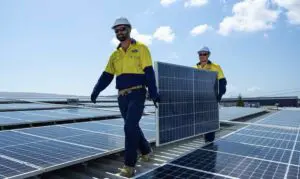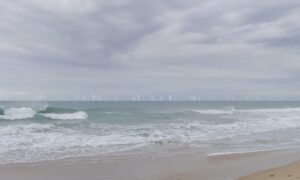Tasmania’s plans for a $3 billion investment in new pumped hydro schemes and a new link to the mainland may turn out to be little more than damp squib, given concerns raised by two new studies in the proposal.
The idea of adding 2,500MW of pumped hydro into Tasmania’s existing hydro system – and using this and its considerable wind resources as a “renewable energy battery” for the mainland – was unveiled with much fanfare by prime minister Malcolm Turnbull, premier Will Hodgman and Hydro Tasmania on Thursday.
But the crucial ingredient in the plan is the construction of a new $1 billion inter-connector to carry all that renewable power to the mainland. And a study by John Tamblyn released on the same day raises considerable doubts about the economic viability of such an investment.
In one “neutral” scenario, drawn up by the Australian Energy Market Operator, the benefits might outweigh costs over a 20 year period by just $20 million. And these benefits might be eroded if battery storage costs continue to fall and utility-scale batteries become widespread, as many predict.
Further complicating the matter is Victoria’s own renewable energy target, which will likely deliver 5,000MW of new capacity by 2025.
“That means that building new renewable generation in Tasmania (1,200MW of wind), timed to coincide with commissioning of the second Bass Strait inter-connector, would not increase projected market benefits,” the report says. Instead, it is likely to “lead to oversupply in the southern regions (Victoria, Tasmania, and South Australia).”
And, in any case, AEMO, says, “additional power system security support is not needed in Victoria because support services (such as Frequency Control) are adequately provided by existing generators in Tasmania and Victoria.”
Tamblyn’s own conclusions are for the Tasmanian government to be cautious. He notes that Tasmania could likely support 730MW of additional wind capacity even without the second inter-connector, and a further 365MW with the new link.
He says that if the new inter-connector is to go ahead, it will likely have to be conditional on a new link from Victoria to South Australia, to ensure that diversity of renewable generation across the regions is used more effectively.
“It reduces the need for higher-cost gas generation by allowing renewable generation in one region to complement the intermittency of renewable generation in another region.”
But even this may not be enough to justify the investment in the other scenarios, which canvass stronger climate targets and greater uptake of distributed generation. Of course, stronger climate targets are desirable, while greater distributed generation seems inevitable given the plunging costs of solar and storage, and the soaring costs of grid power.
AEMO’s 45 per cent emissions reduction scenario, suggesting a more robust climate target for 2030, concluded that despite delivering greater fuel cost savings in this scenario, due to an accelerated retirement of brown coal generation, the interconnection provides minimal capital deferral benefits.
“Increased uptake of large-scale battery storage in all cases dampens the benefit of the additional capacity access provided via the inter-connector,” it said.
The low grid demand scenario, contemplating greater uptake of energy efficiency, rooftop solar, and distributed generation, also didn’t look good for the inter-connector.
 However, Tamblyn said he could not quantify the other benefits of the new link – such as added security, which is critical given that the inquiry was commissioned after the existing Basslink cable was inexplicably cut in 2015, took six months to repair, and coincided with a drought that reduced dam levels and forced the state to turn to diesel generation and load reductions.
However, Tamblyn said he could not quantify the other benefits of the new link – such as added security, which is critical given that the inquiry was commissioned after the existing Basslink cable was inexplicably cut in 2015, took six months to repair, and coincided with a drought that reduced dam levels and forced the state to turn to diesel generation and load reductions.
But there are other questions. Adding 2,500MW of pumped hydro looks like a bad case of oversizing, given that would be more than twice the maximum flows of the interconnector. And there may be environmental concerns – the Mersey Forth system component involved run of river hydro.
The study does include some interesting scenario planning from the AEMO, and its predictions of the energy mix by 2036. In all scenarios, the amount of coal fired capacity is reduced dramatically.
The study draws attention to just how difficult it is to predict the evolution of energy markets over the next 20 years, let alone the 40 year life of new assets such as inter-connectors.
Many prominent people say new inter-connectors are an essential ingredient to a decarbonised grid, because renewable energy from one part of the country can deliver excess capacity to another. But the whole assumption may be undone by the proliferation of distributed energy, and the plunging costs of battery storage.
One thing that is clear – and this comes through in the reports – is that the energy market will change, and change dramatically, as the various AEMO scenarios highlight.
Under the “neutral” scenario, AEMO predicts:
- 63% (15.5GW) of the existing coal generation fleet may retire by 2036.
- Up to 45.3GW of new generation may be required by 2036, comprising wind (20%), large-scale photovoltaic (PV) (29%), gas-powered generation (GPG) (27%), and rooftop PV (25%).
Under the 45% emissions reduction scenario, AEMO projects, by 2035–36, the retirement of 18.2GW of coal plant and the installation of:
- 27.5GW of large-scale renewable generation, comprising 14.8GW of large-scale PV and 12.7GW of wind.
- 11.7GW of GPG.
- 12.0GW of rooftop solar PV.
- 3.5GW of battery storage.
Under the Low Grid Demand scenario, AEMO projects, by 2035–36, the retirement of 18.8GW of coal plant and the installation of:
- 13.4GW of rooftop solar PV.
- 2.5GW of large-scale solar PV.
- 4.7GW of GPG.
- 5.8GW of wind generation.









